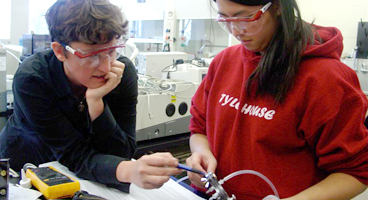Document Type
Article
Publication Date
3-1-2000
Publication Title
Journal of the Acoustical Society of America
Abstract
In clinical measurements of hearing sensitivity, a given earphone is assumed to produce essentially the same sound-pressure level in all ears. However, recent measurements [Voss et al., Ear and Hearing (in press)] show that with some middle-ear pathologies, ear-canal sound pressures can deviate by as much as 35 dB from the normal-ear value; the deviations depend on the earphone, the middle-ear pathology, and frequency. These pressure variations cause errors in the results of hearing tests. Models developed here identify acoustic mechanisms that cause pressure variations in certain pathological conditions. The models combine measurement-based Thevenin equivalents for insert and supra-aural earphones with lumped-element models for both the normal ear and ears with pathologies that alter the ear's impedance (mastoid bowl, tympanostomy tube, tympanic-membrane perforation, and a 'high- impedance' ear). Comparison of the earphones' Thevenin impedances to the ear's input impedance with these middle-ear conditions shows that neither class of earphone acts as an ideal pressure source; with some middle-ear pathologies, the ear's input impedance deviates substantially from normal and thereby causes abnormal ear-canal pressure levels. In general, for the three conditions that make the ear's impedance magnitude lower than normal, the model predicts a reduced ear-canal pressure (as much as 35 dB), with a greater pressure reduction with an insert earphone than with a supra-aural earphone. In contrast, the model predicts that ear-canal pressure levels increase only a few dB when the ear has an increased impedance magnitude; the compliance of the air-space between the tympanic membrane and the earphone determines an upper limit on the effect of the middle-ear's impedance increase. Acoustic leaks at the earphone-to-ear connection can also cause uncontrolled pressure variations during hearing tests. From measurements at the supra-aural earphone-to-ear connection, we conclude that it is unusual for the connection between the earphone cushion and the pinna to seal effectively for frequencies below 250 Hz. The models developed here explain the measured pressure variations with several pathologic ears. Understanding these mechanisms should inform the design of more accurate audiometric systems which might include a microphone that monitors the ear-canal pressure and corrects deviations from normal.
Volume
107
Issue
3
First Page
1548
Last Page
1565
DOI
10.1121/1.428440
ISSN
00014966
Rights
© 2000 Acoustical Society of America
Version
Version of Record
Recommended Citation
Voss, Susan E.; Rosowski, John J.; Shera, Christopher A.; and Peake, William T., "Acoustic Mechanisms that Determine the Ear-Canal Sound Pressures Generated by Earphones" (2000). Engineering: Faculty Publications, Smith College, Northampton, MA.
https://scholarworks.smith.edu/egr_facpubs/77


